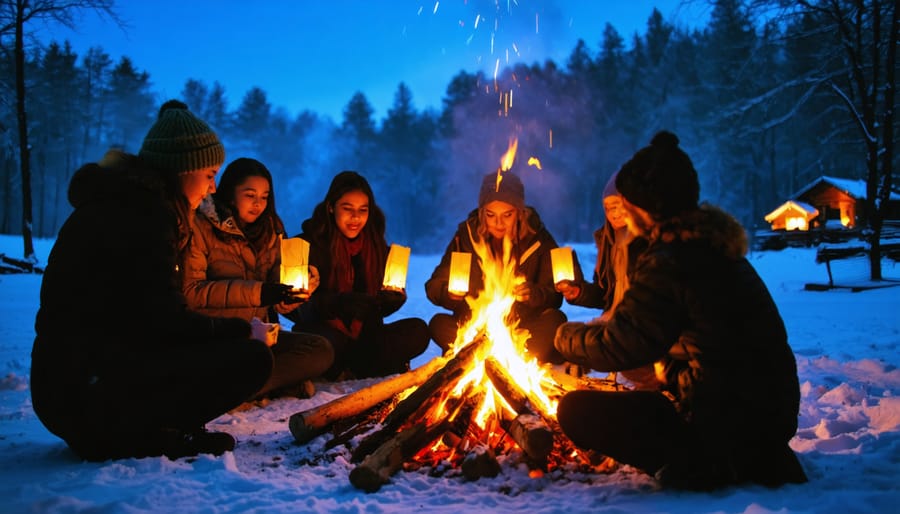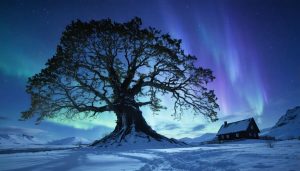The longest night of the year has sparked wonder and reverence across cultures for millennia. As December’s darkness deepens and the sun traces its lowest arc across the sky, communities from the Arctic Circle to the Southern Hemisphere pause to mark this astronomical turning point—the winter solstice. This celestial moment, occurring between December 20-23 in the Northern Hemisphere, represents more than just a date on the calendar; it embodies humanity’s eternal dance with light and darkness, hope and renewal.
Long before twinkling Christmas lights adorned our homes, ancient peoples lit massive bonfires against the winter dark, honoring the sun’s promised return. They understood what modern celebrations sometimes obscure: that midwinter festivals aren’t merely about surviving the cold, but about gathering together in defiance of it, transforming the year’s darkest moment into its most luminous celebration. From Stonehenge’s perfectly aligned stones to the glowing lanterns of Dongzhi Festival, from Scandinavian St. Lucia processions to Indigenous ceremonies honoring the cycles of nature, these winter celebrations worldwide share a common thread: the triumph of light, community, and hope.
Today’s families continue these age-old traditions, often without realizing they’re participating in humanity’s oldest festival. When you string fairy lights, gather loved ones for a special meal, or light candles against December’s early darkness, you’re joining an unbroken chain of celebration stretching back thousands of years. This exploration of solstice traditions reveals not only how different cultures mark winter’s turning point, but how their customs have woven themselves into the very fabric of our modern holiday season—connecting us to ancestors who stood beneath the same winter sky, waiting for the light to return.
When Darkness Reigns: Understanding the Winter Solstice Magic
Picture this: on the longest night of the year, when darkness stretches its velvet cloak across nearly sixteen hours, something absolutely magical happens. The Earth pauses in her celestial dance, tilting at her farthest point from the sun, before slowly pirouetting back toward the light. This moment—the winter solstice—marks the astronomical turning point when the sun reaches its lowest point in the sky, and has captivated human hearts for thousands of years.
Usually falling between December 20th and 23rd in the Northern Hemisphere, the winter solstice isn’t just a date on the calendar. It’s a cosmic promise whispered across the darkness: the light will return. For our ancestors, who lived intimately with the rhythms of nature, this wasn’t mere poetry—it was survival. They watched the days grow shorter with mounting concern, wondering if the sun might abandon them entirely. When the solstice arrived and the days began lengthening again, even by mere minutes, it sparked profound relief and jubilation.
This astronomical event touches something deep within us—a primal understanding that even in our darkest moments, renewal awaits. Ancient peoples marked this pivotal night with bonfires that pushed back the darkness, feasts that defied winter’s scarcity, and gatherings that warmed souls against the cold. They weren’t simply celebrating a celestial occurrence; they were honoring resilience, community, and hope.
Today, when we string twinkling lights through December’s darkness or gather loved ones close during the year’s coldest nights, we’re echoing those ancient celebrations. The winter solstice reminds us that darkness and light exist in eternal partnership, each making the other more precious. In that longest night, cultures across continents found reason to celebrate—not despite the darkness, but because of what lay just beyond it: the gradual, glorious return of the sun.

Scandinavia’s Sacred Fire: Yule and the Norse Traditions
The Yule Log That Burns Away Winter’s Grip
Picture this: a massive oak log, carefully chosen and dragged home through winter’s first snow, destined to burn throughout the longest night of the year. The Yule log tradition reaches back to ancient Norse and Celtic peoples who believed its flames held the power to banish darkness and coax the sun’s return.
Families would gather round as the log—often decorated with evergreen boughs, holly, and ribbons—was ceremoniously placed in the hearth. The lighting ceremony held deep meaning: kindling came from last year’s saved log, symbolizing continuity and the eternal cycle of seasons. As flames danced and crackled, they weren’t merely warming the home; they were participating in ancient magic, burning away winter’s icy grip while welcoming light and renewal.
Today, the Yule log lives on in delightful ways. The chocolate Bûche de Noël graces holiday tables as an edible tribute, while crackling fireplace videos bring the tradition to modern screens. Some families still burn actual logs on the winter solstice, keeping this beautiful custom alive—a bridge between our ancestors’ reverence for nature’s rhythms and our own yearning for warmth, light, and togetherness during the darkest days.
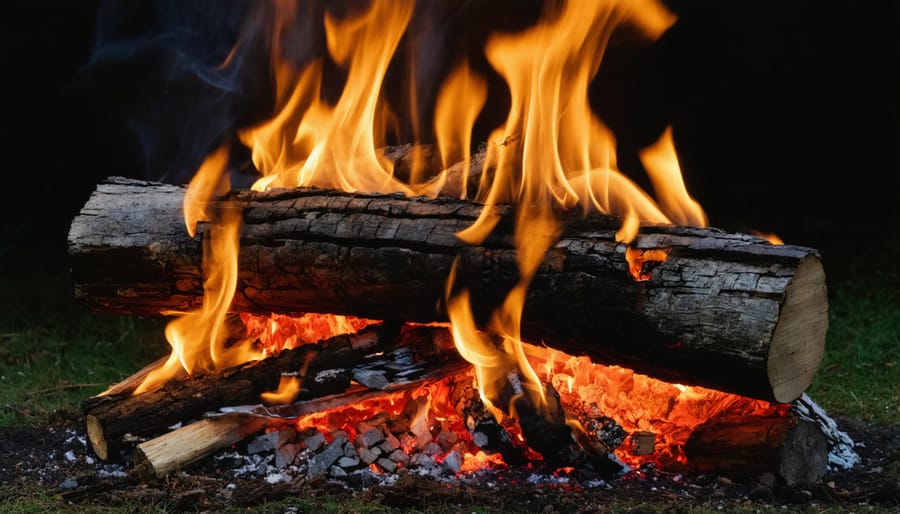
St. Lucia’s Crown of Light
On December 13th, as winter darkness wraps Sweden in its deepest embrace, something magical happens. Long before dawn breaks, a procession of light glides through homes, schools, and churches—a living constellation led by St. Lucia herself.
The tradition centers on a young girl dressed in flowing white robes tied with a crimson sash, her head crowned with a wreath of evergreen branches adorned with glowing candles. She moves through the darkness like starlight personified, followed by attendants in white gowns carrying their own candles. Together, they sing ancient songs that speak of light conquering the longest night, their voices weaving hope through winter’s chill.
This beautiful celebration connects deeply to Swedish Christmas traditions, honoring St. Lucia, a martyr who brought food and aid to Christians hiding in Roman catacombs, wearing candles on her head to light her way. Swedish families embraced her story as a symbol of hope during their darkest season, transforming it into a beloved tradition that marks the beginning of the Christmas season.
The procession often includes sharing saffron buns called lussekatter and ginger cookies, warming both body and spirit. This luminous tradition reminds us that even in our darkest moments, we can be bearers of light for one another—a message that resonates beautifully with Swedish winter celebrations and the universal spirit of the season.
Ancient Stones and Celtic Bonfires: Winter Solstice in the British Isles
Long before twinkling Christmas lights adorned our homes, ancient peoples of the British Isles gathered around roaring bonfires to witness the year’s longest night give way to hope. The Celts and Druids understood something profound about darkness—that it makes the returning light all the more precious.
At the heart of these ancient celebrations stands Stonehenge, that mysterious circle of towering stones on Salisbury Plain. Each winter solstice, as dawn breaks, something magical happens: the sun rises precisely through the monument’s grand trilithon, bathing the ancient altar in golden light. For five thousand years, this astronomical alignment has marked humanity’s oldest appointment with wonder. Today, thousands still gather in the pre-dawn chill, their breath forming clouds in the frigid air, waiting for that first ray of hope to pierce the darkness.
The Druids called this sacred time Alban Arthan, “the Light of Winter.” Communities would kindle enormous bonfires—not just for warmth, but as beacons calling the sun back from its southern journey. Families brought evergreen boughs of holly, ivy, and mistletoe into their homes, reminding themselves that life persists even in winter’s grip. These verdant symbols whispered promises: spring will return, warmth will come again, darkness never wins.
The Celts feasted and told stories through the longest night, their voices rising above crackling flames. They honored the rebirth of the Oak King, who would wrestle sovereignty from the Holly King and bring lengthening days. Children learned that every ending cradles a new beginning within it.
These ancient rituals echo through our modern European Christmas traditions—the Yule log, the decorated evergreen tree, the gathering of loved ones when darkness falls early. The Druids’ wisdom endures: together, we kindle light against the darkness, and together, we welcome its certain return.
The Sun’s Birthday: Festivities Across Ancient Empires
Saturnalia: When Romans Turned the World Upside Down
Imagine a world where masters served their slaves at grand feasts, where dignified senators donned silly pointed hats, and where the solemn halls of Roman villas echoed with laughter and song. This wasn’t chaos—it was Saturnalia, the Romans’ beloved winter celebration that turned society delightfully on its head.
Beginning around December 17th, as the winter solstice approached, Romans honored Saturn, the god of agriculture and time. For nearly a week, the empire paused its usual strictness and embraced pure, unbridled joy. Schools closed, courts adjourned, and even wars halted as citizens devoted themselves to merriment.
The magic of Saturnalia lived in its spirit of reversal and equality. Slaves dined at their masters’ tables, sometimes even being served by them—a radical gesture in ancient Rome. People exchanged small gifts called *sigillaria*, often handmade candles or clay figurines, symbols of goodwill that echo in our modern gift-giving traditions. Homes glowed with lamplight and evergreen decorations, while the air filled with the aroma of roasted meats and honeyed wine.
Everyone wore the *pilleus*, a soft felt cap symbolizing freedom, and the greeting “Io Saturnalia!” rang through streets day and night. This wasn’t mere festival—it was a reminder that beneath titles and stations, all people shared common humanity and deserved moments of joy, especially during winter’s darkest days.
Yalda Night: Persia’s Longest Night of Poetry and Pomegranates
On the longest night of the year, Iranian families gather around the korsi—a low table draped with heavy quilts and warmed from beneath—creating a cozy haven against winter’s chill. This is Shab-e Yalda, an ancient Persian celebration that transforms darkness into an opportunity for togetherness, where the night itself becomes a canvas for love, poetry, and hope.
The tradition stretches back thousands of years to Zoroastrian times, when Persians believed that staying awake through the winter solstice would help the sun triumph over darkness. Today, families honor this legacy by filling their tables with symbolic fruits: ruby-red pomegranates representing the cycle of life, juicy watermelons that seem impossibly summery in December, and bowls of dried fruits and nuts called ajil.
But the true magic of Yalda lies in an enchanting ritual called fal-e Hafez. Family members take turns making wishes, then randomly opening the collected poems of Hafez, the beloved 14th-century Persian poet. The verse they land upon becomes their fortune, sparking lively discussions about metaphors and meanings. Elders interpret the mystical lines while children lean in close, mesmerized by the melodic Persian words.
As laughter mingles with poetry and pomegranate seeds stain fingers crimson, Yalda reminds us that even the darkest night holds promise—for dawn always follows, and spring will return again.
Eastern Light: Asia’s Winter Solstice Treasures
As winter’s darkness deepens across East Asia, families gather to welcome the returning light through celebrations steeped in ancient wisdom and heartwarming traditions. The Dongzhi Festival—meaning “winter’s arrival”—transforms the year’s longest night into a precious moment of togetherness and hope.
In homes throughout China, Taiwan, and neighboring regions, kitchens fill with the delightful bustle of making tangyuan, those perfectly round sweet rice balls that symbolize unity and completeness. Grandmothers guide little hands in rolling the soft dough, sharing stories passed down through generations as the spheres take shape. Some families tuck sweet fillings of black sesame paste or peanut inside, while others prefer them plain, floating in ginger-infused syrup like tiny moons in a warm, comforting sky.
The beauty of Dongzhi lies in its philosophical heart. According to ancient Chinese wisdom, the winter solstice marks the pivotal moment when yin energy reaches its peak and yang begins its gradual return. This dance between darkness and light, cold and warmth, reminds us that even in our coldest seasons, brighter days are already taking shape beneath the surface. Families often prepare special dishes—particularly warming soups and stews—believing that nourishing the body during this transition strengthens health throughout the coming year.
Journey eastward to Japan, where the winter solstice—called Toji—brings its own enchanting customs. Picture this: a steaming bath scattered with golden yuzu citrus fruits, their bright fragrance filling the air like captured sunshine. This beloved ritual, practiced in homes and public bathhouses alike, warms both body and spirit while warding off winter colds. The floating yuzu, with their cheerful color and invigorating scent, embody hope and vitality precisely when nature seems most dormant.
Japanese families also savor kabocha squash on Toji, its vibrant orange flesh symbolizing the sun’s eventual triumph over winter’s grip. Children delight in counting the yuzu bobbing in the bath, while parents soak away the year’s weariness, emerging renewed and ready to embrace the lengthening days ahead.
These Eastern traditions remind us that celebrating the solstice isn’t merely marking an astronomical event—it’s about gathering our loved ones close, honoring cycles larger than ourselves, and kindling hope’s eternal flame against the winter dark.
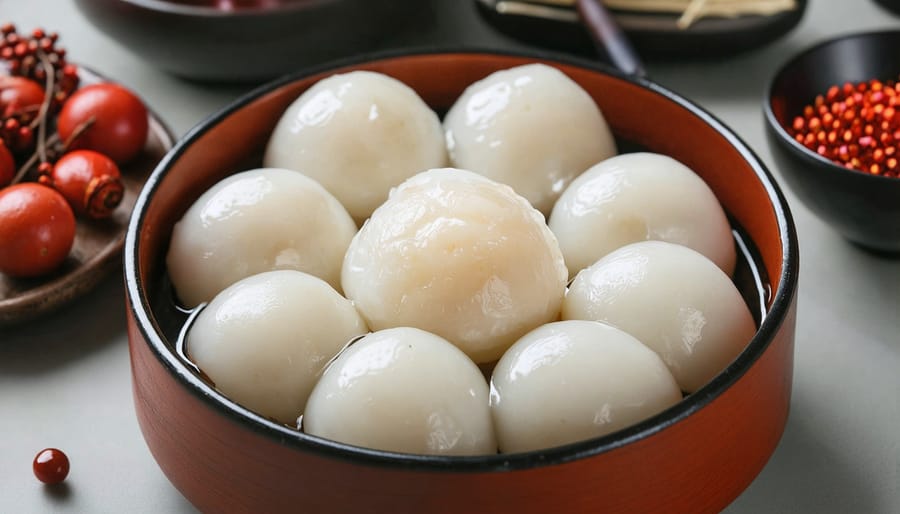
Indigenous Wisdom: Native American Solstice Ceremonies
In the heart of the American Southwest, where ancient mesas reach toward brilliant winter skies, Native American communities have celebrated the winter solstice for countless generations. These sacred ceremonies carry profound meaning, honoring the sun’s journey and welcoming its promised return to strengthen the earth.
Among the Pueblo peoples of New Mexico and Arizona, the winter solstice marks a time of deep spiritual significance. Families gather in their adobe homes, sharing stories passed down through the ages about the sun’s life-giving power. The preparations begin weeks in advance, as communities ready themselves for ceremonies that have remained largely unchanged for over a thousand years.
The Hopi Soyal ceremony stands as one of the most beautiful and meaningful winter solstice traditions. This sacred ritual, which typically begins around December 21st, spans sixteen days of prayer, purification, and renewal. Kachina dancers emerge, their intricate costumes adorned with vibrant feathers and symbolic designs, each movement telling stories of creation and rebirth. The ceremonies take place in underground kivas—ceremonial chambers that serve as sacred spaces where earth and sky meet in prayer.
During Soyal, prayer sticks are carefully crafted and blessed, then placed at shrines to carry wishes for the coming year. The air fills with the haunting melodies of traditional songs, smoke from sacred fires rises skyward, and the community reaffirms its connection to the cycles of nature. Elders teach younger generations about responsibility to the earth and the delicate balance between humans and the natural world.
The Zuni people celebrate Shalako, welcoming spiritual messengers who bring blessings for the new year. Meanwhile, other Pueblo communities hold their own unique ceremonies, each reflecting their distinct cultural heritage while sharing the universal theme of gratitude for the sun’s return and hope for abundant harvests ahead.
These timeless traditions remind us that winter’s darkness carries the promise of spring’s light—a message of hope that resonates across all cultures and generations.
Bringing Arctic Solstice Magic Into Your Home
The longest night of the year holds a special kind of magic—one that invites us to slow down, gather close, and celebrate light returning to our world. You don’t need elaborate plans to weave the enchantment of winter solstice into your family’s December traditions. Sometimes the simplest rituals become the most cherished memories.
Begin your solstice evening by gathering everyone as the sun begins its descent. This is the perfect time to honor candlelight traditions that have warmed homes for centuries. Place candles throughout your living space—on windowsills, mantels, and your dining table—then light them together as twilight deepens. Let each family member share something they’re grateful for as they illuminate their chosen candle. The soft glow transforms an ordinary evening into something sacred and memorable.
In the kitchen, prepare foods that celebrate abundance and hope. Bake cinnamon-scented breads shaped like suns, stir pots of warming spiced cider, or roast root vegetables harvested from autumn’s bounty. Many cultures feast on the solstice, recognizing that even in darkness, we have provisions to sustain us. Let children help knead dough or string dried oranges and cranberries for edible decorations—their little hands making magic alongside you.
Crafting together adds another layer of meaning. Create simple sun wheels from evergreen branches, gold ribbon, and pinecones. Fashion luminarias from paper bags filled with sand and tea lights to line your walkway. Or start a solstice journal where family members write wishes for the returning light—dreams they hope to nurture as days grow longer.
As the longest night settles around you, bundle up and venture outside. Even a brief moment under the winter stars connects you to countless generations who’ve watched these same constellations. Tell stories about how ancient peoples celebrated this turning point, imagining their relief and joy as they anticipated spring’s eventual return.
The winter solstice reminds us that darkness is temporary, that light always returns, and that gathering together makes every season brighter. These simple rituals—the candles, the food, the crafts, the stories—weave threads of wonder through your family’s December celebrations, creating traditions your children will carry into their own homes someday.
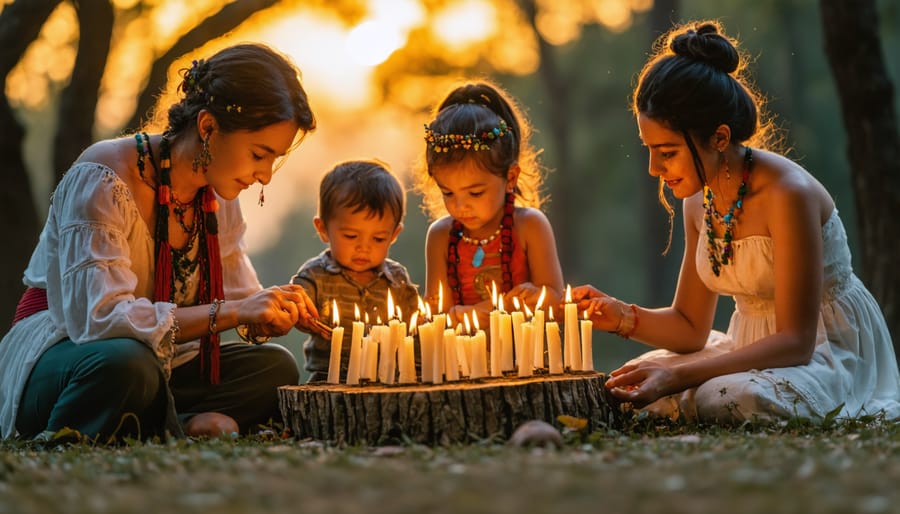
Across frozen tundras and bustling cities, from ancient stone circles to cozy living rooms, humanity has always answered the winter solstice’s darkness with the same beautiful defiance: we create light. Whether it’s the golden glow of menorah candles, the crackling warmth of a Yule log, or paper lanterns floating toward star-filled skies, we’ve never accepted that the longest night would last forever.
These cherished traditions—some thousands of years old, others freshly reimagined—remind us that we’re part of an unbroken chain of hopeful souls who gazed into winter’s depth and chose celebration over surrender. Our ancestors knew what we sometimes forget in our busy modern lives: that gathering together, sharing stories and meals, and kindling flames against the cold are revolutionary acts of faith in brighter days ahead.
This year, as the solstice approaches, consider starting your own meaningful ritual. Light candles at twilight with your children and share stories of the sun’s return. Bake something fragrant that fills your home with warmth. Step outside after dark to marvel at winter stars, those ancient witnesses to countless generations celebrating this very night.
Because here’s the magic they all understood: the light always returns. Day by day, minute by minute, it grows stronger. And we, with our luminous traditions and loving gatherings, get to welcome it home together—just as families have done since the very first winter, and will continue doing for winters yet to come.


